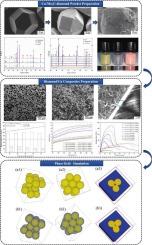Surface modification of hard diamond particles with Cu-Mo2C double layer coating and its application in thermal conductive composites
IF 5.1
3区 材料科学
Q2 MATERIALS SCIENCE, COATINGS & FILMS
引用次数: 0
Abstract
Thermal conductive composites were fabricated with a unique method using Cu-Mo2C double layer coated diamond particles. Molybdenum carbide coating was prepared by the molten salt method to promote interfacial bonding in the composites. The reacting substance of MoO3 and diamond surface was analyzed and the reacting process was clarified. With electroless plating, copper layer was deposited as the outer layer. The powder size distribution and pressing property of the synthetic particles were further analyzed, which confirmed that the copper layer was formable and thick enough to replace copper powders for the composite matrix. The Cu-Mo2C coated diamond particles were compacted by cold pressing and then sintered under vacuum. Thermal conductivity of 65 vol% diamond/Cu composite produced in this way reached 622 Wm−1 K−1 which was much higher than that of the composite using uncoated diamond. The coefficient of thermal expansion of 70 vol% diamond/Cu composite reached as low as 5.40 × 10−6/K which was more compatible with those of semiconductor materials. The significantly improved thermal physical properties can be ascribed to the perfect adhesion of Mo2C layer at the interface and the uniform distribution of diamond particles because of the coating copper layer. In addition, the nailing effect and grain refining mechanism of diamond particles during copper sintering were studied based on the phase field method. The results show that diamond can effectively inhibit the grain growth and promote the grain refining of copper matrix, which is a unique sintering phenomenon for double layer coated diamond powders.

Cu-Mo2C双层涂层对硬质金刚石颗粒的表面改性及其在导热复合材料中的应用
采用Cu-Mo2C双层包覆金刚石颗粒,采用独特的方法制备了导热复合材料。采用熔盐法制备碳化钼涂层,促进复合材料界面结合。分析了MoO3与金刚石表面的反应物质,阐明了反应过程。采用化学镀法,镀铜层作为外层。进一步分析了合成颗粒的粉末粒度分布和压制性能,证实了铜层的可成形性和厚度足以取代铜粉作为复合基体。对Cu-Mo2C包覆金刚石颗粒进行冷压压实,真空烧结。用这种方法制备的65 vol%金刚石/Cu复合材料的导热系数达到了622 Wm−1 K−1,远远高于未涂层金刚石复合材料的导热系数。70 vol%金刚石/Cu复合材料的热膨胀系数低至5.40 × 10−6/K,与半导体材料的热膨胀系数相适应。热物理性能的显著改善可归因于Mo2C层在界面处的完美粘附和涂层铜层使金刚石颗粒均匀分布。此外,利用相场法研究了铜烧结过程中金刚石颗粒的钉钉效应和晶粒细化机理。结果表明:金刚石能有效抑制晶粒长大,促进铜基体晶粒细化,这是双层金刚石粉末特有的烧结现象;
本文章由计算机程序翻译,如有差异,请以英文原文为准。
求助全文
约1分钟内获得全文
求助全文
来源期刊

Diamond and Related Materials
工程技术-材料科学:综合
CiteScore
6.00
自引率
14.60%
发文量
702
审稿时长
2.1 months
期刊介绍:
DRM is a leading international journal that publishes new fundamental and applied research on all forms of diamond, the integration of diamond with other advanced materials and development of technologies exploiting diamond. The synthesis, characterization and processing of single crystal diamond, polycrystalline films, nanodiamond powders and heterostructures with other advanced materials are encouraged topics for technical and review articles. In addition to diamond, the journal publishes manuscripts on the synthesis, characterization and application of other related materials including diamond-like carbons, carbon nanotubes, graphene, and boron and carbon nitrides. Articles are sought on the chemical functionalization of diamond and related materials as well as their use in electrochemistry, energy storage and conversion, chemical and biological sensing, imaging, thermal management, photonic and quantum applications, electron emission and electronic devices.
The International Conference on Diamond and Carbon Materials has evolved into the largest and most well attended forum in the field of diamond, providing a forum to showcase the latest results in the science and technology of diamond and other carbon materials such as carbon nanotubes, graphene, and diamond-like carbon. Run annually in association with Diamond and Related Materials the conference provides junior and established researchers the opportunity to exchange the latest results ranging from fundamental physical and chemical concepts to applied research focusing on the next generation carbon-based devices.
 求助内容:
求助内容: 应助结果提醒方式:
应助结果提醒方式:


